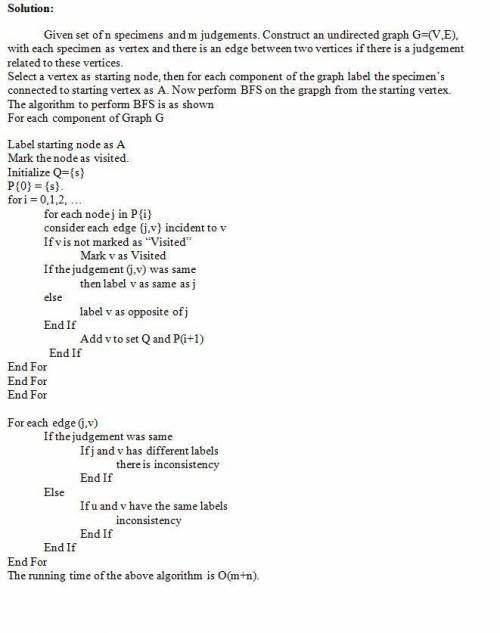
Engineering, 07.03.2020 03:32 surfer89
Inspired by the example of that great Cornellian, VladimirNabokov, some of your friends have become amateur lepidopterists (they study butter- flies). Often when they return from a trip with specimens of butterflies, it is very difficult for them to tell how many distinct species they’ve caught—thanks to the fact that many species look very similar to one another.
One day they return with n butterflies, and they believe that each belongs to one of two different species, which we’ll call A and B for purposes of this discussion. They’d like to divide the n specimens into two groups—those that belong to A and those that belong to B—but it’s very hard for them to directly label any one specimen. So they decide to adopt the following approach.
For each pair of specimens i and j, they study them carefully side by side. If they’re confident enough in their judgment, then they label the pair (i, j) either "same" (meaning they believe them both to come from the same species) or "different" (meaning they believe them to come from different species). They also have the option of rendering no judgment on a given pair, in which case we’ll call the pair ambiguous.
So now they have the collection of n specimens, as well as a collection of m judgments (either "same" or "different") for the pairs that were not declared to be ambiguous. They’d like to know if this data is consistent with the idea that each butterfly is from one of species A or B. So more concretely, we’ll declare the m judgments to be consistent if it is possible to label each specimen either A or B in such a way that for each pair (i, j) labeled "same," it is the case that i and j have the same label; and for each pair (i, j) labeled "different," it is the case that i and j have different labels. They’re in the middle of tediously working out whether their judgments are consistent, when one of them realizes that you probably have an algorithm that would answer this question right away.
Give an algorithm with running time O(m + n) that determines whether the m judgments are consistent.

Answers: 1


Another question on Engineering

Engineering, 04.07.2019 18:10
Air is to be cooled in the evaporator section of a refrigerator by passing it over a bank of 0.8-cm-outer-diameter and 0.4-m-long tubes inside which the refrigerant is evaporating at -20°c. air approaches the tube bank in the normal direction at 0°c and 1 atm with a mean velocity of 4 m/s. the tubes are arranged in-line with longitudinal and transverse pitches of sl- st 1.5 cm. there are 30 rows in the flow direction with 15 tubes in each row. determine (a) the refrigeration capacity of this system and (b) pressure drop across the tube bank. evaluate the air properties at an assumed mean temperature of -5°c and 1 atm. is this a good assumption?
Answers: 1

Engineering, 04.07.2019 18:10
True or false (explain) (110)[111] is a slip system in bcc metals . the {111} family in fcc contains 8 planes. resolved shear stress (rss) in single crystals is just related to the applied stress. critical resolved shear stress (crss) in single crystal metals is direct proportional to the number of defects in the structure
Answers: 2

Engineering, 04.07.2019 18:20
Asimple rankine cycle uses water as the working fluid. the water enters the turbine at 10 mpa and 480c while the condenser operates at 6 kpa. if the turbine has an isentropic efficiency of 80 percent while the pump has an isentropic efficiency of 70 percent determine the thermal efficiency
Answers: 1

Engineering, 04.07.2019 19:10
Tom is having a problem with his washing machine. he notices that the machine vibrates violently at a frequency of 1500 rpm due to an unknown rotating unbalance. the machine is mounted on 4 springs each having a stiffness of 10 kn/m. tom wishes to add an undamped vibration absorber attached by a spring under the machine the machine working frequency ranges between 800 rpm to 2000 rpm and its total mass while loaded is assumed to be 80 kg a) what should be the mass of the absorber added to the machine so that the natural frequency falls outside the working range? b) after a first trial of an absorber using a mass of 35 kg, the amplitude of the oscillation was found to be 10 cm. what is the value of the rotating unbalance? c) using me-3.5 kg.m, find the optimal absorber (by minimizing its mass). what would be the amplitude of the oscillation of the absorber?
Answers: 3
You know the right answer?
Inspired by the example of that great Cornellian, VladimirNabokov, some of your friends have become...
Questions

Mathematics, 24.07.2019 14:10

History, 24.07.2019 14:10

History, 24.07.2019 14:10


Mathematics, 24.07.2019 14:10


Chemistry, 24.07.2019 14:10

Social Studies, 24.07.2019 14:10

Mathematics, 24.07.2019 14:10



History, 24.07.2019 14:10


History, 24.07.2019 14:10

History, 24.07.2019 14:10

Biology, 24.07.2019 14:10







